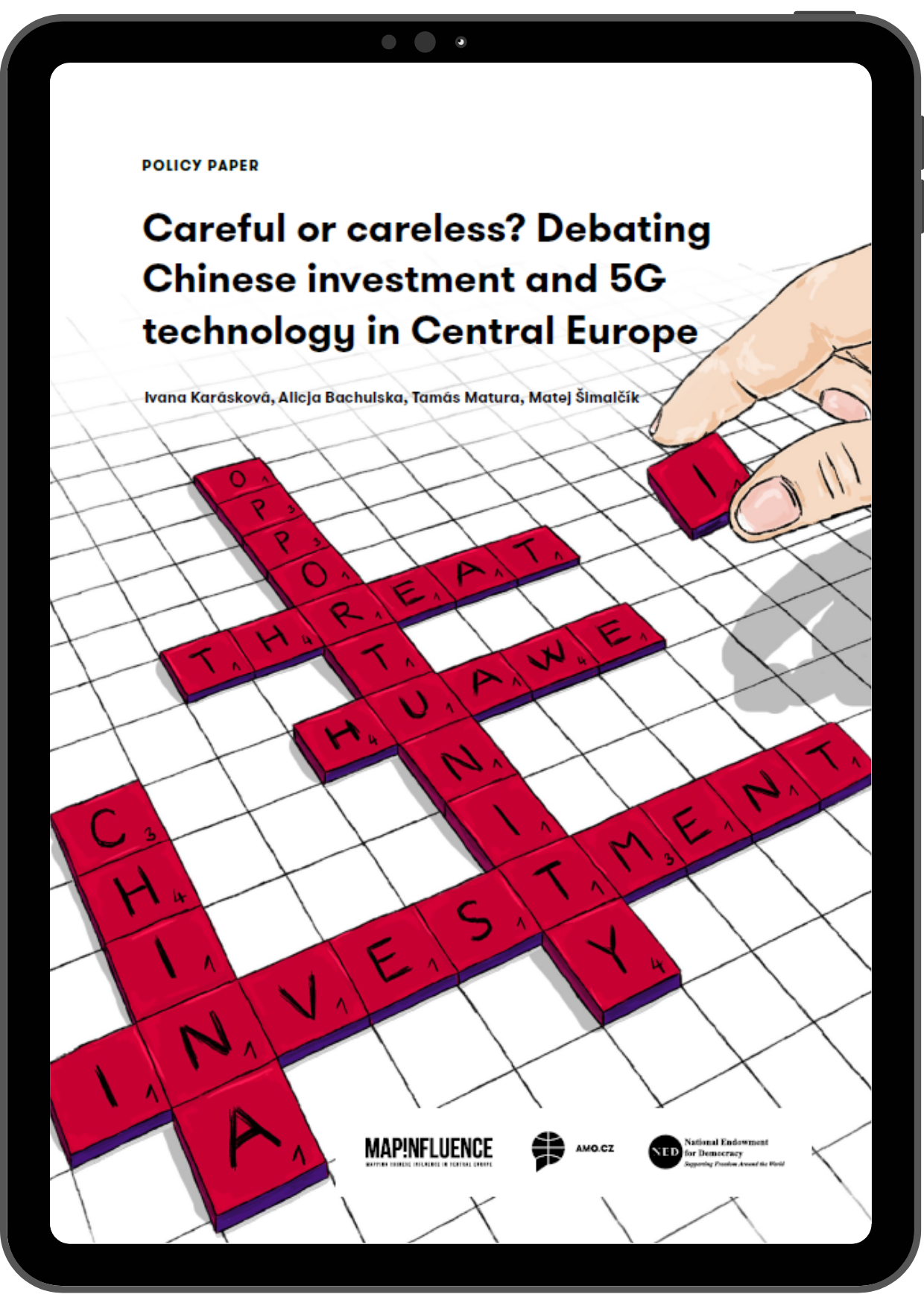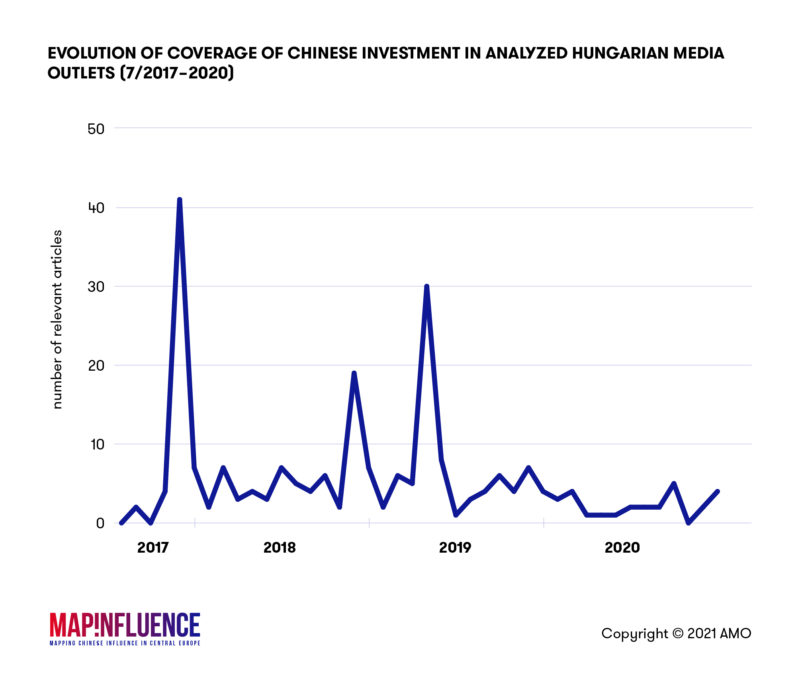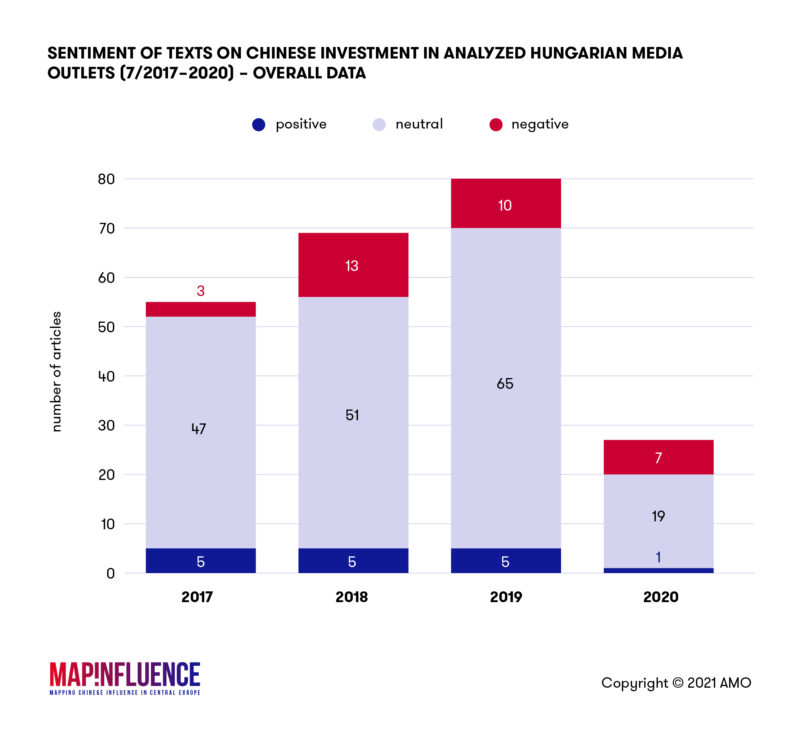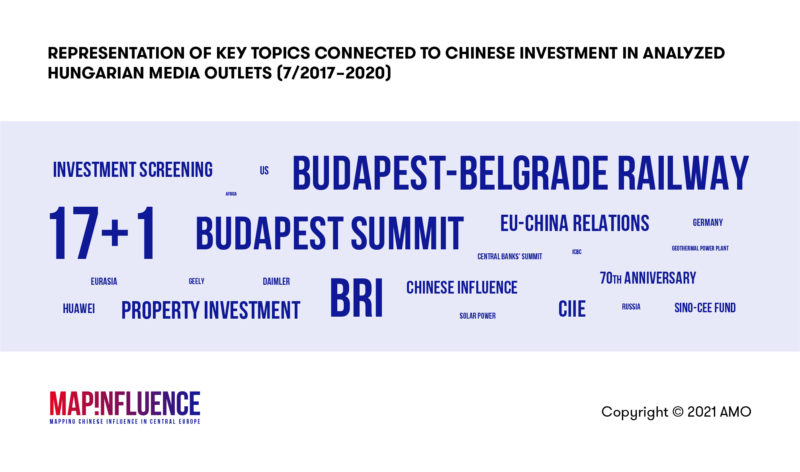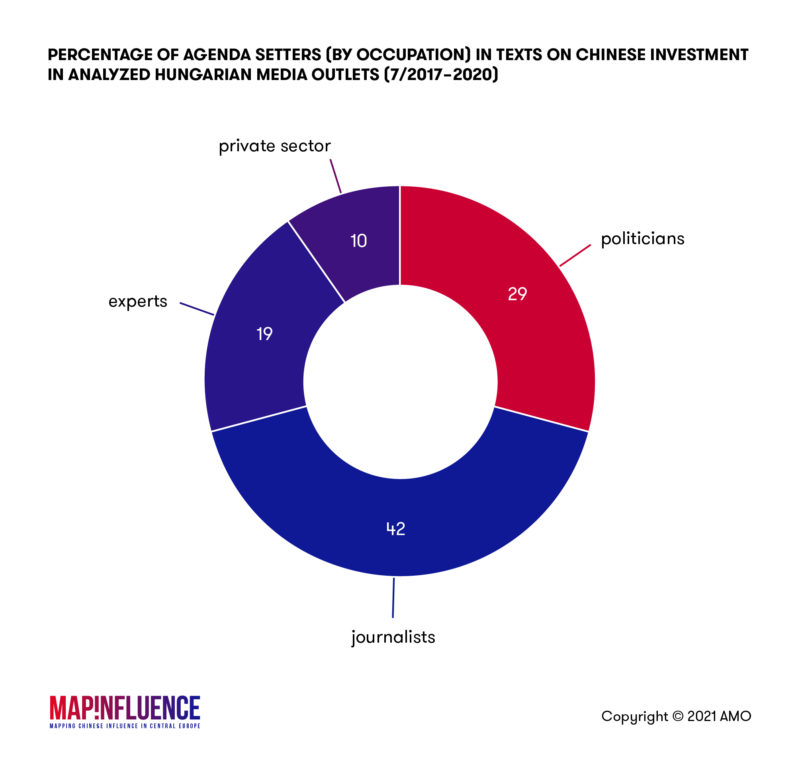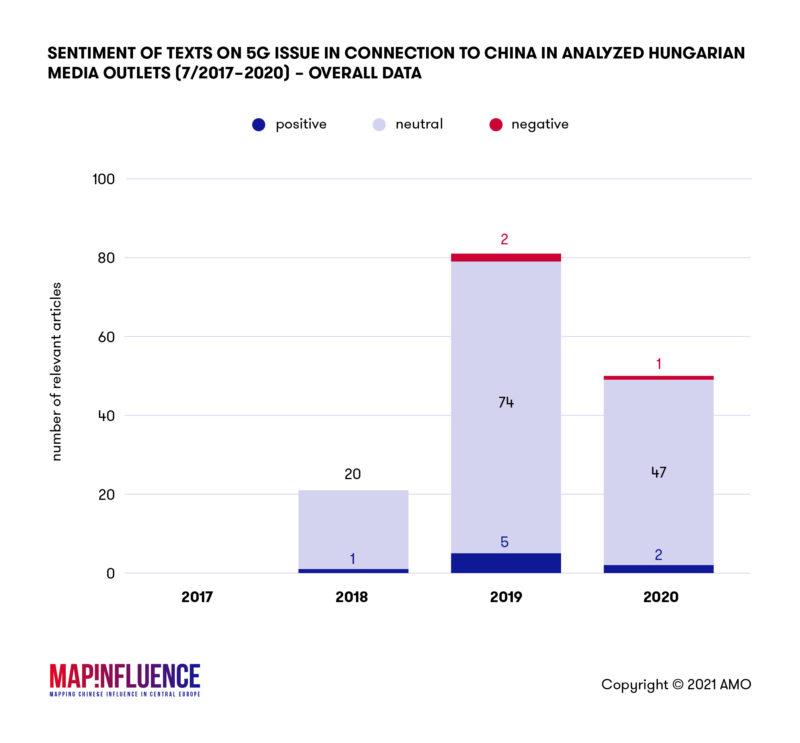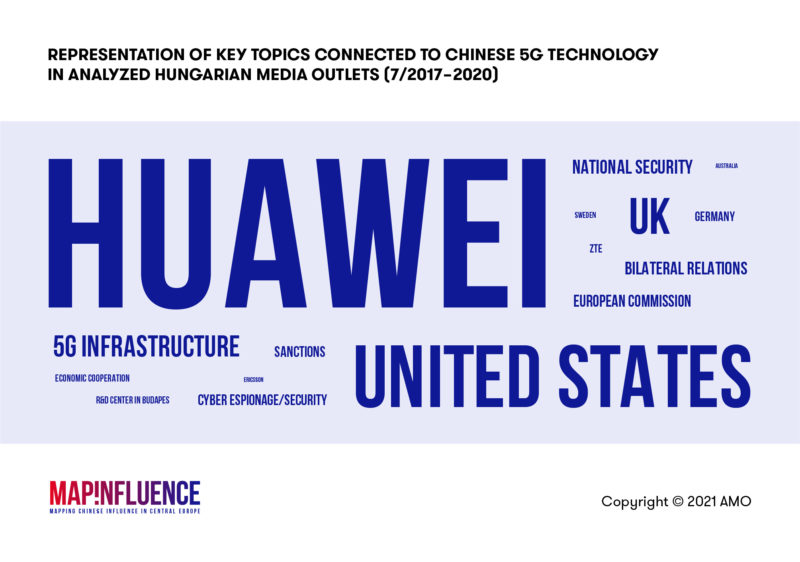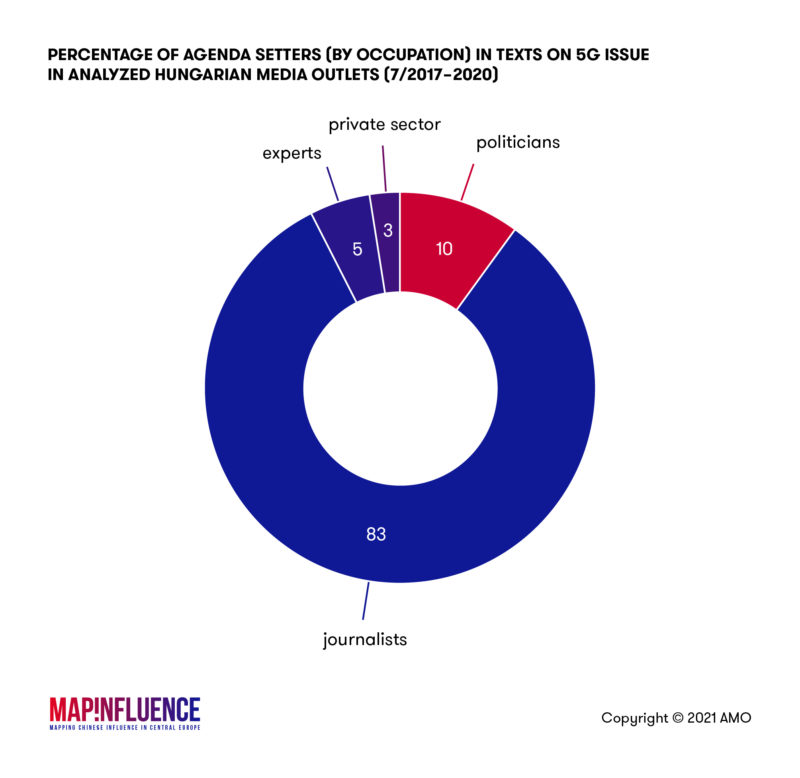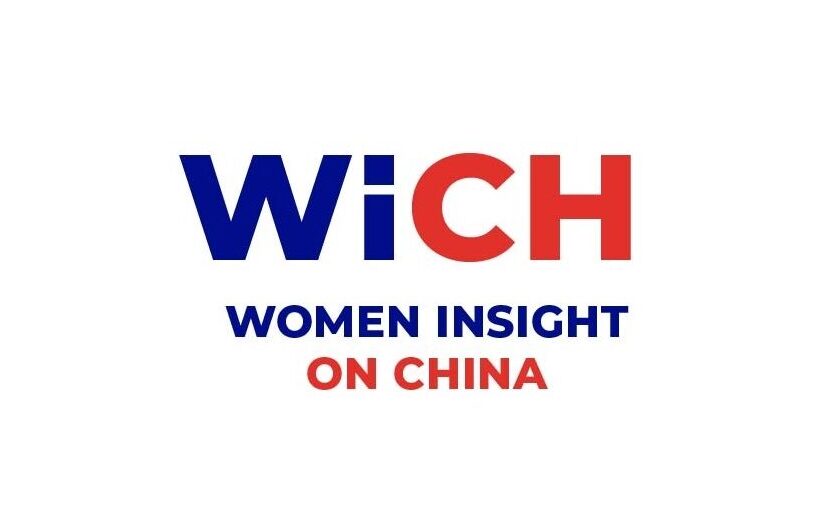Analysis of China-Related Issues in Hungarian Media (2017-2020)

This project builds on the previous extensive research, which analyzed texts published by the Hungarian media about China in the period from 2010 to June 2017. This comprehensive study was part of a discursive analysis of China’s media coverage in four Central European countries. The findings of this project contributed to the necessary shift in awareness of media vulnerabilities and integration of the media into European and national mechanisms for foreign investment screenings.
MapInfluenCE’s analysts subsequently expanded their research to the following period, from mid-2017 to 2020. As media attention focused on topics related to China significantly increased, the research covered only two key topics – Chinese investment and China’s potential involvement in building 5G networks.
As part of the analysis, 15 Hungarian media were assessed, based on their popularity in the Hungarian audience in the considered period. The resulting dataset contained 152 texts on 5G networks and 241 texts on Chinese investments.
The results of the analysis are provided in the following infographics. The full detailed study covering Poland, Czechia, Slovakia and Hungary and providing context, interpretation of results and recommendations, is available below.
Chinese Investment
The media coverage on Chinese investment in Hungary does not follow a clear trend line, as media outlets seem to be generally uninterested in the topic, except for three spikes in November 2017, November 2018 and April 2019. The low number of articles may be explained by the fact that Hungary did not receive any tangible major Chinese investment in the analyzed period. Meanwhile, the three spikes are connected to major diplomatic events: the Budapest summit of the 16+1 took place in November 2017, the China International Import Expo in Shanghai, and the China-CEEC Central Bank Governors’ Meeting in Budapest both took place in November 2018, while April 2019 marked the second Belt and Road Forum in Beijing and the visit of the president of the Sino-CEE Fund in Budapest.
Similar to the period covered by our previous research, the Hungarian media coverage was mostly neutral about both topics of concern, though the division line between pro-government and independent media is once again clear and obvious. Over three-quarter of news coverage was neutral about China’s investment, 14 percent negative and 10 percent positive.
When it comes to investment relations, it was mostly major diplomatic events that have shaped the narrative. Chinese investment in Hungary was mentioned mostly in media coverage on China-CEE summits and Belt and Road Forums. Naturally, the renovation of the Budapest-Belgrade railway connection was the most frequently mentioned specific project, as the story has been developing for many years.
The extensive coverage of property investment is a unique feature of the Hungarian discourse, in comparison to the media discourse on Chinese investment in other V4 countries. Thanks to the golden visa program of the Hungarian government, over 15,000 Chinese immigrants arrived in Hungary between 2013 and 2017. Even though most do not actually live in the country, thousands of them have bought apartments in Budapest, which may have contributed to the property price boom at the time. Consequently, the role they play in the property market has become a major topic ever since.
Similar to the situation in the other V4 countries, the main drivers of the discourse were journalists and politicians, not experts. When it comes to the topic of Chinese investment in Hungary, a handful of politicians played a pivotal role in shaping the narrative. Péter Szijjártó, the Hungarian Minister of Foreign Affairs and Trade, represented 44 percent of quotes made by politicians alone.
5G Networks
When it comes to the issue of China’s involvement in the development of 5G networks, the pattern of coverage in Hungary looks similar to Slovak and Polish results. There were three longer peak periods, with the first one between late 2018 and mid-2019, the second from late 2019 to early 2020, and the last one in the second half of 2020. The first wave of 5G-related articles was unleashed by the arrest of Huawei CFO Meng Wanzhou in Canada and the first moves against Huawei by US President Donald Trump, followed by the reactions of the EU and the UK. The second peak in late 2019 was reached when Péter Szijjártó, the Minister of Foreign Affairs and Trade, announced that Huawei would cooperate with Hungary in building the country’s 5G network. Huawei-related public communications of other EU countries kept the wave riding till early 2020, followed by a short decline in coverage right before the third (double) spike in the second half of 2020.
Similar to other countries in Central Europe, we can observe a relative decline in the number of articles discussing Chinese investment and 5G-related issues in 2020 compared to the previous year. This may be explained by the coronavirus pandemic as public attention has turned towards the virus, and all diplomatic events that could have attracted media coverage were canceled.
It is noteworthy that the issue of Chinese investment was more divisive than the topic of Chinese 5G-related activities, as in the case of the latter, 93 percent of the coverage was neutral, 2 percent negative and 5 percent positive. The highly neutral discourse on the 5G technology might be explained by the technical nature of the topic. Most articles have mentioned US concerns, but tried to balance them by presenting the counterarguments of the Hungarian government and Huawei as well.
Hungarian media discourse on China’s involvement in the development of 5G networks was mostly driven by international events, while domestic factors were missing from the debate. Articles revolved around Donald Trump’s comments on and sanctions against Huawei, and the subsequent reactions of the EU and its members like the UK and Sweden. Since the Hungarian government has expressed its unquestionable intention to include Huawei into the development of the 5G network of the country at an early stage of the international debate,63 there was no more room left for a substantial domestic debate. Consequently, the media simply reported on the international developments of the 5G issue, and the debates in Western countries.
The theme of Chinese 5G systems was dominated by journalists to an incredibly high share, that is, many of the articles covering the topic did not quote any politicians, experts, or representatives of the private sector. Instead, media outlets mostly relied on foreign sources like Western news agencies and translated their articles. Given that domestic discourse was always shallow on the matter, journalists had no other option but to cover foreign news related to the development of the 5G issue.
Interested in comparing the results with the situation in the other V4 countries? Check out the data from the country analyses below.
